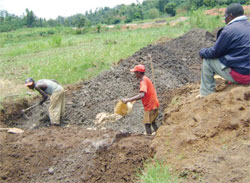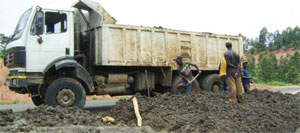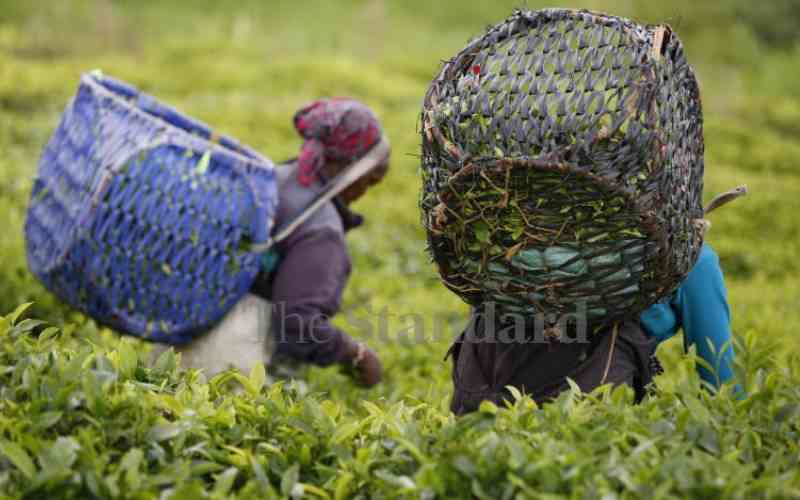By Peter Orengo
Lucas Gathangu watches as his two sons pile a truck with clay soil from his four-acre farm in Rutune in Mukurweini.
Being Saturday and a market day, the village is abuzz with activities as villagers stream into market to sell farm produce.
For years, Gathangu produced vegetables on his farm until a stranger arrived and offered to harvest clay from the lower part of his farm.
Since that part of his farm had produced nothing for decades, Gathangu was happy to let the businessman harvest the clay. He was told the clay would be used in making pottery.
What Gathangu did not know is that his farm has been yielding harvesting ball clay, a multi-million shilling resource used to make certain types of ceramics.
 |
Labourers excavate ball clay in Mukurweini. Once processed, the material is used to produce a range of products, including ceramics, porcelain and bricks. Photo: Peter Orengo/Standard
|
It is only found in the lower parts of Giathugu, Rutune and Thanu locations of Mukurueni in central Kenya.
"He proposed Sh7, 000 for a lorry-full, an offer I could not refuse. This was to happen every Saturday. Now I can make Sh28,000 a month for my family. I wasn’t making that much when I only sold vegetables," Gathangu ratioanalises.
According to Paul Mwitaria, a senior Research Scientist at Kenya Industrial Research and Development Institute (KIRDI), ball clay is a unique geological formation of a rare clay soil worth millions, yet few people are aware of it.
Natural deposits
"Ball clay in Mukurueni basin took millions of years to fill from rivers that flowed out of Mt Kenya. The natural deposits have resulted in a clay that is purer and more refined than any others in the whole country," Mwitaria told The Standard recently.
He says the special clay is derived from decomposed granite sediments, a metamorphosis of kaolin, which deposits in swampy areas. It is scarce because its deposits are a combination of geological factors needed for their formation and preservation.
"The acids formed due to decomposition of vegetation and animal matter can break the kaolin to finer particles. The result is that the cohesion of properties increases as the whiteness gets reduced," he adds.
Ceramics made from ball clay are said to be much harder than those made of other clay. Because of its rarity and quality, products made from ball clay are very expensive compared to other clays.
In Kenya, the clay is used in making crockery, bricks, porcelain and decorations.
But it is also exported and blended with other clays to make a wide range of products such as ceramics, bricks, tires, porcelain, glossy magazines, medicines and even toothpaste.
"Porcelain made out of ball clay is particularly heat-resistant and the most good-looking in the ceramics clay family. Thus its sheer beauty it is widely used in making crockery like dinner plates," says Mwitaria.  |
The fruits of their labour: Manual workers load ball clay from a farm in Mukurweini, one of the of the few spots in Central province where the material is found naturally. A lorry load costs Sh7,000 although it is worth a lot more. |
Its pure white clay retains that colour after the firing process, he says. The temperature at which the clay is fired makes it dense and hard so it does not crack easily as sand and other residues are minimal.
Throw-away price
For ball clay to benefit the local community Kirdi and the Mukurweini community last week entered a pact that will see the extraction and processing of the clay.
Richard Maina, who is the Mukurweini Constituency Development Fund co-ordinator described the MOU as a milestone for the people of Mukurweini, who for years were selling the clay at a throw-away price.
"For us it has been a dream- come true. We were surprised to hear that we had a unique commodity which was being harvested for years but did not benefit the people," Maina said.
He added, "People used to come with lorries to offer Sh7,000 to be sold later for millions of shillings. Now that we know the value of ball clay, we will make sure our people benefit from it and even sustain its extraction."
Casual jobs
Mukurweini Member of Parliament, Kabando wa Kabando who was instrumental in negotiating the MOU with KIRDI says viable extraction of ball clay in Mukurweini will be its contribution to the national agenda of Vision 2030.
"We have lived in Mukurweini anticipation that the clay would be used to lift the lives of our local people. We are proud that the raw material is only found in this constituency. The impact will benefit people beyond our boarders," said Kabando.
Even though clay is a naturally occurring material and you could potentially use it directly out of the ground, Kabando said.
"We expect to produce functional materials like pots, mugs, bowls and generally stoneware and brand them as coming from Mukurweini," the MP, who is also Sport Assistant minister, said.
 The Standard Group Plc is a multi-media organization with investments in media
platforms spanning newspaper print operations, television, radio broadcasting,
digital and online services. The Standard Group is recognized as a leading
multi-media house in Kenya with a key influence in matters of national and
international interest.
The Standard Group Plc is a multi-media organization with investments in media
platforms spanning newspaper print operations, television, radio broadcasting,
digital and online services. The Standard Group is recognized as a leading
multi-media house in Kenya with a key influence in matters of national and
international interest.
 The Standard Group Plc is a multi-media organization with investments in media
platforms spanning newspaper print operations, television, radio broadcasting,
digital and online services. The Standard Group is recognized as a leading
multi-media house in Kenya with a key influence in matters of national and
international interest.
The Standard Group Plc is a multi-media organization with investments in media
platforms spanning newspaper print operations, television, radio broadcasting,
digital and online services. The Standard Group is recognized as a leading
multi-media house in Kenya with a key influence in matters of national and
international interest.











